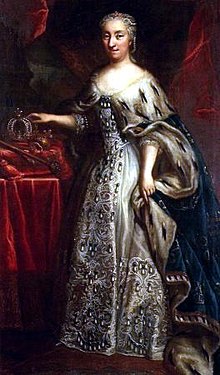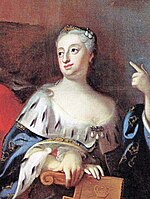Ulrika Eleonora of Sweden
| Ulrika Eleonora | |
|---|---|
 | |
| Queen of Sweden | |
| Reign | 5 December 1718 – 29 February 1720 |
| Coronation | 17 March 1719 |
| Predecessor | Charles XII |
| Successor | Frederick I |
| Born | 23 January 1688 Stockholm Palace, Sweden |
| Died | 24 November 1741 (aged 53) Stockholm, Sweden |
| Burial | |
| Spouse | Frederick I of Sweden |
| House | House of Palatinate-Zweibrücken |
| Father | Charles XI of Sweden |
| Mother | Ulrika Eleonora of Denmark |
| Religion | Lutheran |

Ulrika Eleonora or Ulrica Eleanor (23 January 1688 – 24 November 1741), also known as Ulrika Eleonora the Younger, was Queen regnant of Sweden from 5 December 1718 to 29 February 1720, and then Queen consort until her death.
She was the youngest child of King Charles XI and Queen Ulrika Eleonora the Elder and named after her mother. After the death of her brother King Charles XII in 1718, she claimed the throne. Her late older sister, Princess Hedvig Sophia had left a son, Charles Frederick of Holstein-Gottorp, who had the better claim by primogeniture. But Ulrika Eleonora asserted that she was the closest surviving relative of the late king (the idea of proximity of blood) and cited the precedent of Queen Christina. She was recognized as successor by the Riksdag after she had agreed to renounce the powers of absolute monarchy established by her father Charles XI. She abdicated in 1720 in favor of her consort, Landgrave Frederick I of Hesse-Kassel.
Princess and regent
Ulrika Eleonora lived most of her life under the shadow of others, outshone by her brother the king, and by her beautiful sister, who was her brother's informal heir. In 1700, there were negotiations about a marriage to Frederick William I of Prussia, but nothing came of it.[1] She was later made the god-mother of Louisa Ulrika of Prussia, who was given the name Ulrika after her.[1] A princess and spinster, she took care of her dominating grandmother, Hedwig Eleonora of Holstein-Gottorp, during her brother's absence in the Great Northern War. Her older sister, Hedvig Sophia, was then the heir to the throne.
Her situation began to change after the death of her older sister in 1708. As her brother refused to marry, and as she was the only royal representative in Sweden, she was in 1713 named as regent during the king's absence by the government and by her grandmother, and thus became a pawn of the many powers struggling for influence in a country without a real heir. The choice now stood between Ulrika Eleonora and her nephew. Her accession as regent and president of the parliament was treated with great enthusiasm. The Riksdag had opposed her brother as they wanted to abolish the absolute monarchy and reinstate their own power.
After her grandmother's death in 1715 she became the center of the court, and this was most likely one of the most happy periods of her life. In 1715 she married Landgrave Frederick I of Hesse-Kassel. The marriage, which on her side was a love-match, become another attempt to use her as a political puppet. Frederick had married her with the intent to reach the throne, and immediately began plotting to have her named heir in place of her nephew. The "Hesse-party" and the "Gottorp-party" stood against each other in the struggle to the throne.
Queen regnant
When Charles XII was killed in 1718, the "Hesse-party" secured Ulrika Eleonora's succession to the throne. They gained the support of the Riksdag opposition, who wanted to end the absolute monarchy established in 1680 and reinstate parliamentary rule.
To accomplish this, Ulrika Eleonora had to consent to a new constitution, which greatly limited the power of the monarch. She was formally elected monarch and crowned in Uppsala in March 1719. During her short period as monarch, to secure support for her rule, she ennobled many families. In fifteen months, she created one hundred and eighty one noble titles, more than any other monarch in Swedish history: one count, two barons, and eight lesser noblemen every month. She had seven field marshals where her brother only had between three and five. Her favorite was Emerentia von Düben (1669–1743), her old nurse, who had been ennobled and made lady-in-waiting in 1707 and with whom she had a close relationship all her life; Düben acted as her advisor, her comfort and support, and was not said to have abused her influence - they were described as sisters.
Ulrika Eleonora was in fact in favor of an absolute monarchy. She had agreed to the new constitution only to secure the throne from her nephew. She supported her husband's political ambitions and wanted him to become co-ruler, following the example of William III and Mary II of England, but this was not permitted by the Riksdag, as co-reigning had been forbidden in Sweden since the 15th century. She therefore abdicated in his favor after reigning only one year. This succession was confirmed by the Riksdag. She often spoke of the abdication as the great sacrifice of her life. Frederick succeeded her as Frederick I in 1720.
Her reign occurred just before the end of the Great Northern War.
Queen consort

Ulrika Eleonora had married for love and was known to be fiercely loyal to Frederick. At least until 1724, the Queen expressed the hope that she would give birth to an heir, but the marriage was childless.[2] Frederick had mistresses. His extramarital affairs increased after he lost much of his royal authority in 1723. In 1730, Frederick became the first king in Swedish history to have an official mistress, the young noblewoman Hedvig Taube, who was given the title countess of Hessenstein. The Queen's reaction to this has never been known and she never commented on it; but she withdrew from court and devoted herself to religion and charity.[2] In spite of this withdrawal, she was made regent during Frederick's absence in 1731 and in 1738. During her 1738 regency, she banned the newly founded Swedish theatre by refusing to extend their access to Bollhuset. Her reason for this was opposition toward the theatre among the clergy. The theatre, however, was restored the year after that.
Queen Ulrika Eleonora died of smallpox in 1741. The reigns of Ulrika Eleonora and her husband were the start the period traditionally known as the Age of Liberty, when the monarchy lost most of its power to the nobility.
Personal life
Ulrika Eleonora was interested in jewelry, music, and collected coins. She liked to dance at court balls, and she also hired German and French theatre companies to perform in Bollhuset. She could interrupt a parliamentary session to pray. At court receptions she interrogated young ladies about the Bible, rewarding them for correct answers. She was a stern believer in her royal pride, and pretended to be sick and locked herself in her rooms when she was offended.
Ancestors
References
- Lindqvist, Herman (2006). Historien om alla Sveriges drottningar ("History of the Queens of Sweden"). Norstedts Förlag. ISBN 91-1-301524-9.
- http://runeberg.org/sbh/dubeneme.html (in Swedish)
- Nordisk familjebok. B. 30. Stockholm (1920) (in Swedish)
- Byström, Tryggve. Svenska komedien 1737-1754 ("The Swedish comedy 1737-1754") (in Swedish)
External links
- People from Stockholm
- Swedish monarchs
- Swedish queens
- Rulers of Finland
- Dukes of Bremen and Princes of Verden
- House of Palatinate-Zweibrücken
- House of Wittelsbach
- Female regents
- Female rulers of Finland
- Queens regnant
- Deaths from smallpox
- Infectious disease deaths in Sweden
- Swedish monarchs of German descent
- 1688 births
- 1741 deaths
- Burials at Riddarholmen Church
- Hereditary Princesses of Hesse-Kassel
- Landgravines of Hesse-Kassel
